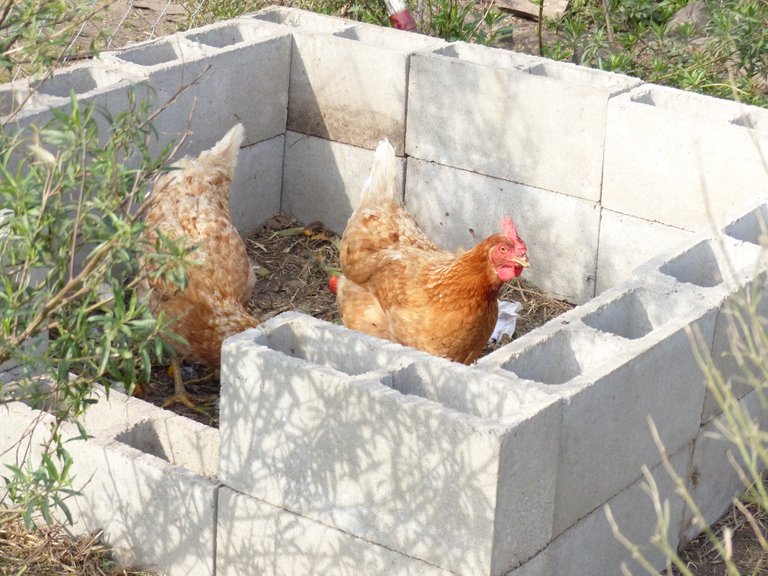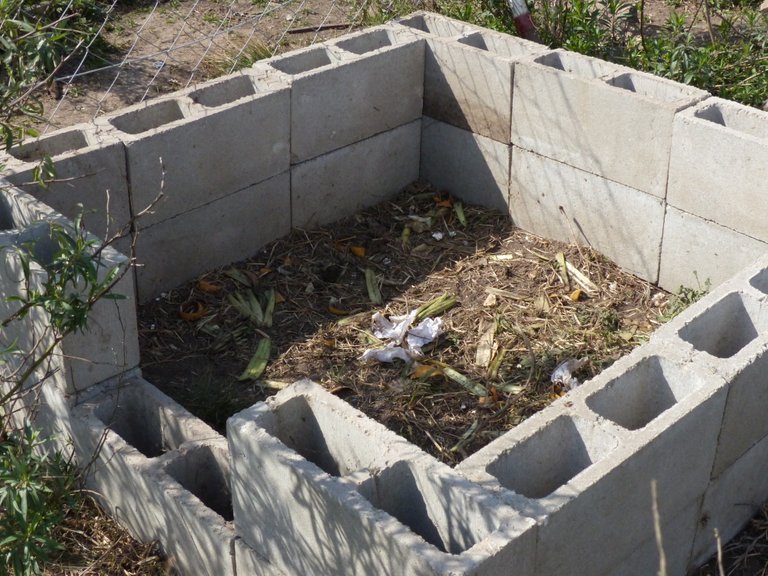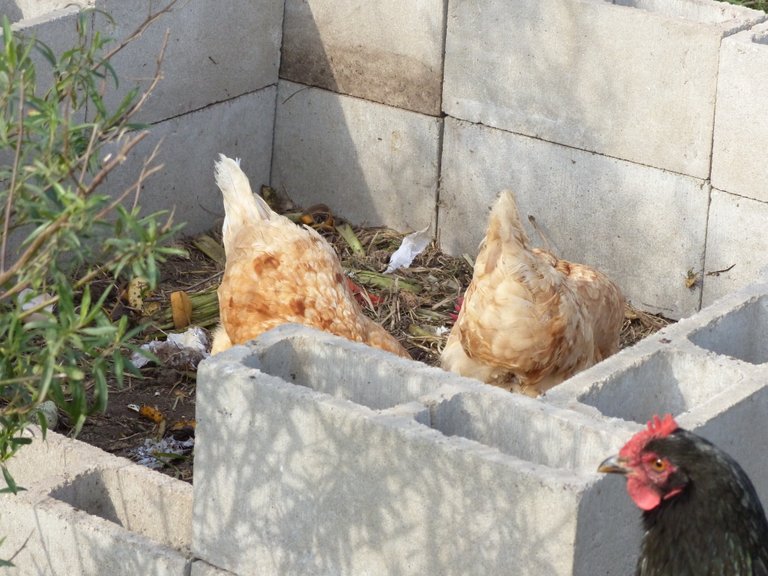[ENG-SPA] Moving the compost bin to the chicken run (is it a good idea?) Moviendo la compostera al gallinero (¿es una buena idea?)

We have a problem with compost. Chickens and dogs love it. It's very difficult to keep it away from these animals: they always find a loophole to get into the compost bin and do their thing. So we came up with an idea. Instead of having the compost bin inside the vegetable garden, as it is usually done, why not place it directly in the chicken run? We don't know if it's a good idea, but we've been trying it out for a few days now and so far it's working great.
When the chickens started to go into the garden compost bin, we had some fears. There are many ways to make compost. Some are almost like baking recipes, with rigorously measured ingredients. This is not our case. We make a "wild" compost, so to speak. The technique is very simple: everything that is organic goes into an open compost bin, basically a pile with some bricks to contain it. Even all the stuff that people say shouldn't be put in the compost. It may not be the best way to do it, but it's the only way that, for the time being, we can incorporate into an already complicated family routine. Chickens, for their part, will eat just about anything, but there are some foods that are supposedly off-limits and are often found in our compost, such as potato peels, dairy scraps and fruit seeds. The hens, however, were entering the compost bin regularly for a year or so and had no health problems, so we assume they know how to choose which foods to eat and which not to eat. In any case, between the chickens escaping into the garden and accessing the compost bin on a daily basis, and the compost bin being in the chicken run itself, there is not much difference.
One problem with placing the compost in the coop is that the amount of compost generated will be less. This is true, but the amount of feed eaten by the eight hens (who, in addition, have about 300 square meters to move freely and forage for their own food) will also be less. On the other hand, as the hens do not eat everything that is in the compost bin, part of it will be composted, in addition to the poop that the hens leave behind while they are in the compost bin. The circuit is also closed when we use the litter from the chicken coop (dry grass with a large amount of chicken poop) to fill the raised beds of the garden. Each bed is then transformed into a kind of additional compost bin, which, moreover, is not very conspicuous for the dog or the hens.



[SPA]
Tenemos un problema con el compost. Las gallinas y los perros lo aman. Es muy difícil mantenerlo alejado de estos animales: siempre encuentran un resquicio para entrar a la compostera y hacer de las suyas. Se nos ocurrió entonces una idea. En lugar de tener la compostera dentro de la huerta, como suele hacerse, ¿por qué no ubicarla directamente en el gallinero? No sabemos si es una buena idea, pero hace unos días que la estamos probando y por ahora viene funcionando de maravillas.
Cuando las gallinas empezaron a entrar a la compostera de la huerta, nos surgieron algunos temores. Hay muchas formas de hacer compost. Algunas son casi como recetas de pastelería, con los ingredientes medidos rigurosamente. No es nuestro caso. Nosotros hacemos un compost “salvaje”, por llamarlo de algún modo. La técnica es muy sencilla: todo lo que es orgánico va a una compostera a cielo abierto, básicamente una pila con algunos ladrillos que sirven para contenerla. Incluso todas las cosas que dicen que no deben colocarse en el compost. Quizás no sea la mejor forma de hacerlo, pero es la única que, por el momento, podemos incorporar en una rutina familiar ya de por sí complicada. Las gallinas, por su parte, comen casi de todo, pero hay algunos alimentos que supuestamente están prohibidos y que con frecuencia se encuentran en nuestro compost, como las cáscaras de papa, restos de lácteos y semillas de frutas. Las gallinas, sin embargo, estuvieron entrando a la compostera de manera regular durante más o menos un año y no tuvieron problemas de salud, por lo que suponemos que saben elegir qué alimentos comer y cuáles no. En todo caso, entre que las gallinas se escapen a la huerta y accedan a la compostera a diario, y que la compostera se encuentre en el gallinero mismo, no hay mucha diferencia.
Un problema de colocar el compost en el gallinero es que la cantidad de compost generada será menor. Esto es cierto, pero también será menor la cantidad de alimento que coman las ocho gallinas (que, además, tienen unos 300 metros cuadrados para moverse libremente y buscar su propia comida). Por otra parte, como las gallinas no comen todo lo que está en la compostera, una parte se irá compostando, a lo que se sumará la caca que las gallinas vayan dejando mientras están dentro de la compostera. El circuito, además, se cierra cuando usamos la cama del gallinero (pasto seco con una gran cantidad de caca de gallina) para rellenar los bancales elevados de la huerta. Cada bancal, entonces, se transforma en una especie de compostera adicional, que, además, no es muy llamativa para la perra ni para las gallinas.
Original in Spanish. Translated with Deepl.
All photographs are our own.
Original en español. Traducido con Deepl.
Todas las fotografías son propias.
Yay! 🤗
Your content has been boosted with Ecency Points, by @laschilcas.
Use Ecency daily to boost your growth on platform!
Support Ecency
Vote for new Proposal
Delegate HP and earn more
There is a company in the US which produces compost and they also have a chicken flock that feeds exclusively on that compost and the bugs mycelium in it. I've also read about people doing deep litter composting with chickens. I have often wondered whether they would end up eating something bad, but I guess as long they are all enough fed they know what not to eat.
Very interesting what you say. I was afraid too, but seeing that they were going into the compost bin anyway, I lost it little by little. The chickens are well fed, they eat chicken feed and have on average 40 square meters or so each to forage on, so they don't need to feed on the compost to live. However, I am still concerned about the problems they might have in the long run, so if possible I will try to compost elsewhere if I get too much of anything that might be bad for them.
Congratulations @laschilcas! You have completed the following achievement on the Hive blockchain and have been rewarded with new badge(s):
Your next target is to reach 200 upvotes.
You can view your badges on your board and compare yourself to others in the Ranking
If you no longer want to receive notifications, reply to this comment with the word
STOPCheck out the last post from @hivebuzz:
Support the HiveBuzz project. Vote for our proposal!
Nunca pensé que las gallinas podrían comer algo tóxico del compost. Cuando fuí a Mexico e hice compost allá, también se metían. Tal vez habría suficiente que comer porque creeme que nunca se comían los restos de la comida! Nomás les gustaba meterse para escarvar y buscar insectos y otros animalillos que ayudan a descomponer los restos.
Pero ¡hay! como son de dañinas las gallinas. No dejaban que mis chicharos se desarrollaran!
Claro, yo noto que son bastante selectivas, comen lo que les gusta de los restos de comida y el resto lo dejan ahí. Yo las tengo separadas de la huerta. Recién este año logré hacer una cerca que funcione. El problema es que mi perra le encontró el gusto a los huevos y hace agujeros para entrar al gallinero y, entonces, las gallinas se escapan y van a la huerta. Espero que esta vez la perra no pueda entrar y también que pueda retomar la huerta, que la tengo casi abandonada. ¡Salaudos!